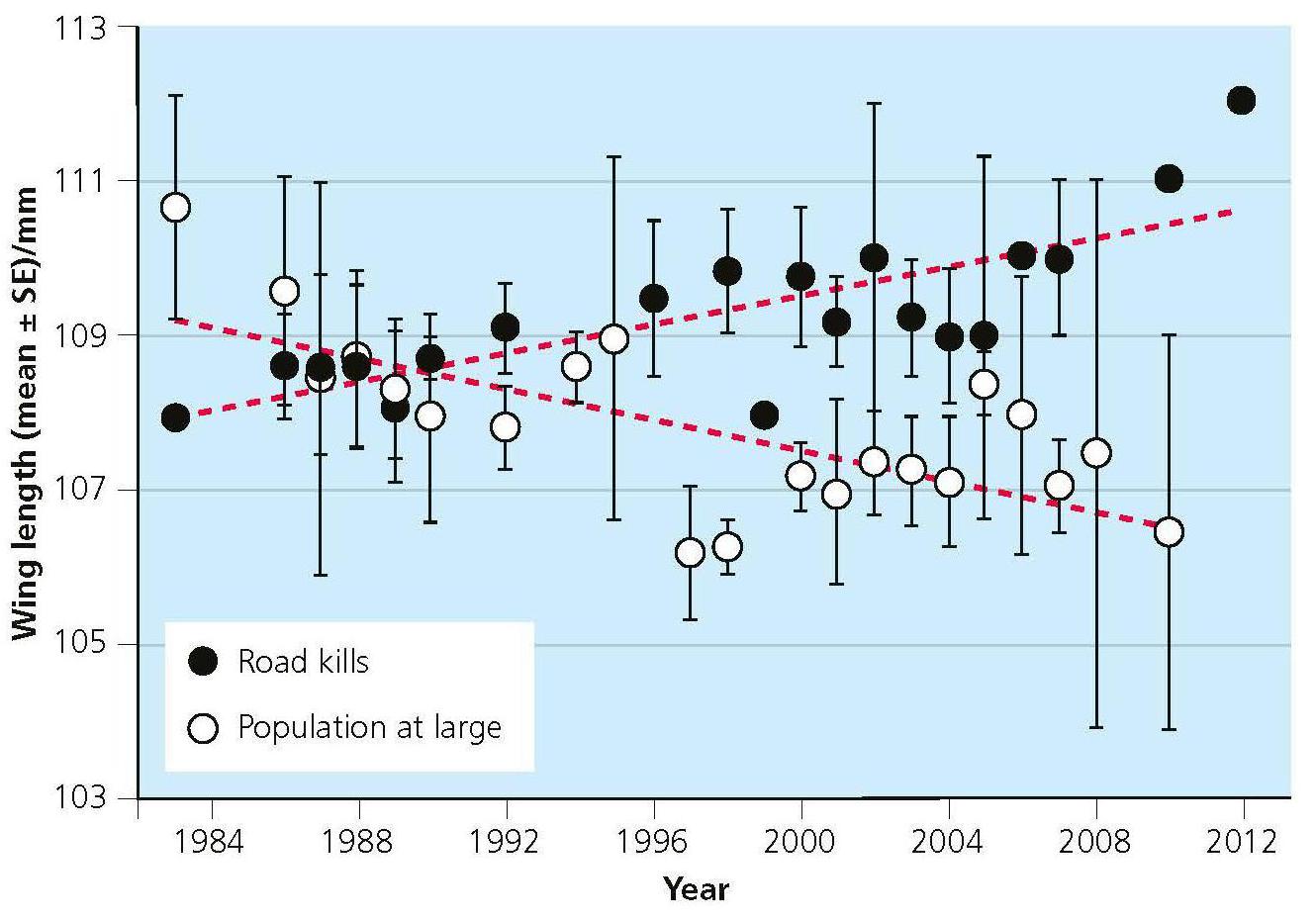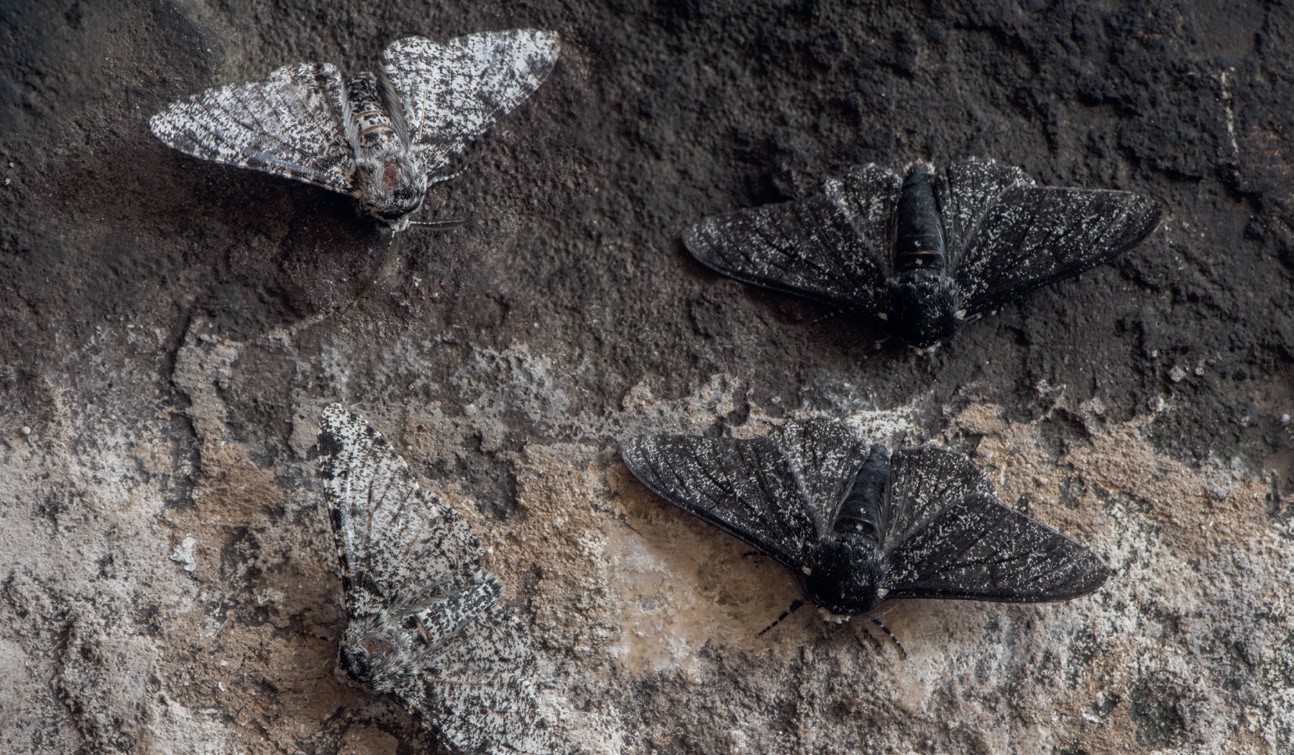BIOETHICS
Evolution in the twenty-first century
Some animals are thriving in human environments, adapting to them through natural selection. Rebecca Nesbit introduces some examples and considers ethical issues associated with how humans respond to evolutionary changes that arise as a result of human activity

How many wild animals have you seen today? Even if you live in a city, you are surrounded by wild species, from pigeons and foxes to bees and mosquitoes. Many have acquired adaptations, through natural selection, that make them better able to survive in environments that have been moulded by human activity. But should humans take some responsibility for these changes, which occur because we alter the world to suit our own needs? And should we attempt to manage both the environment and the animals – including their genes?
Behavioural adaptations
One way in which humans may have unintentionally altered the genetics of a wild species is by giving them food. In Britain, the constant supply of food from bird feeders throughout the year has altered the migratory patterns of blackcaps. These delicate brown birds are easy to identify if you are lucky enough to catch a glimpse. The male is black on the top of his head, whilst the female has a matching cap of russet red. In recent decades more blackcaps have been spending the winter in British gardens in the south and west of England, rather than migrating to Spain. This is partly because climate change has made British winters warmer, but it may also be because of garden bird food encouraging birds to stay put. Evidence comes partly from the long-term data we have about British birds, much of them provided by volunteer recorders through the British Trust for Ornithology’s Garden BirdWatch.
These data show that blackcaps are more likely to be found in gardens where there is bird food. Furthermore, scientists have put tracking devices on blackcaps in Britain and Ireland and measured their body condition. Those that spend time in gardens have, on average, better body condition and rear more chicks successfully than those that do not.
Not only is blackcap migratory behaviour changing, but there is also evidence that this migratory behaviour is genetically controlled. Breeding experiments have shown that the compass direction of a blackcap’s migration is closely linked with the parents’ migratory direction, regardless of whether they were reared by those parents.
More recently, scientists have sequenced blackcap genomes and found genetic differences between sedentary populations and migratory populations. The genomic regions that differ are believed to be important for the genetic control of migratory behaviour. The changes appear to be in regions of DNA that regulate gene expression, rather than in the genes themselves.

Physical adaptations
It is not just behaviour that is changing. In some species body shapes are too. In Nebraska (midwestern USA), American cliff swallows began to build nests beneath bridges. Bridges are ideal solid structures for nesting, but birds flying out of their nests were dangerously close to fast cars. Initially many swallows were killed by vehicles. However, in 2010 scientists published a study showing that the number of swallows dying on the roads had declined by 90% over three decades. The change was not in the traffic, but in the swallows themselves.
When the researchers first started taking measurements of the swallows in 1983 they found that living birds had the same average wing length as those killed by vehicles. By 2012 this had changed – the wings of live birds were half a centimetre shorter (see Figure 1). It was hypothesised that birds with shorter wings were better at flying upwards from their nest thus avoiding the cars.

The swallows were under selection pressure to have shorter wings. Because shorter-winged birds were less likely to be killed, they were more likely to survive to breed and pass on the allele(s) of the gene(s) for short wings.
Sometimes, physical changes are so striking that we do not need measurements to detect them. The most famous example is that of the peppered moth, Biston betularia. In 1848 a moth collector in Manchester was surprised to find a very dark peppered moth – the result of a chance mutation. All the ones he had caught before were a lighter mottled black and white, but this one was almost black.
These dark moths became more common in industrial cities until they were the dominant form, and the reason was soot from burning coal. The soot was deposited on trees, rendering the bark black and killing the lichen that normally gave a mottled appearance. Now the dark form of moth was more camouflaged and less likely to be eaten by birds. The lighter form was easily visible to predators.
City air is now less polluted than it was during the industrial revolution, and the dark form is declining. I catch moths in my urban garden using a bright light to attract them, and have only ever seen the lighter form of the peppered moth.

Science does not have all the answers
New technologies have provided insights into adaptations to human environments. Often, however, the more we discover the more we realise we do not know. The London Underground rail network provides a perfect example.
The common house mosquito, Culex pipiens, is one of the most widespread mosquito species in the world. It has made the London Underground rail network its home. However, life underground is very different from life on the surface, so different adaptations are favoured by natural selection. For a start, common house mosquitoes feed mostly on the blood of birds, but in the Underground they feed on rats and people. Also, the network is always warm, so the mosquitoes can breed throughout the year.
These changes have been suggested as an example of rapid adaptation, with mosquitoes evolving by natural selection in the Underground. Geneticists from the University of London found that the genome of mosquitoes living in the Underground differed from that of those living above ground. But this does not prove that evolution is happening. Recent analysis suggests an alternative explanation.
London’s underground mosquitoes are genetically similar to underground mosquitoes found everywhere from the USA to Kazakhstan, suggesting that all these mosquitoes may have a common origin. One hypothesis is that mosquitoes adapted to life underground evolved thousands of years ago in the Middle East and later spread to London.
The story of the London Underground mosquitoes is complex, and debates about their origin will no doubt continue as more data are collected.

The ethics debate
Having seen examples of evolutionary adaptations of animal species to environments that are created as a result of human actions, we should ask: ‘Does it matter?’ We are often told that human impacts are bad for the natural world, but the reality is more complex.
Part of deciding whether it matters is knowing what impact it has. As science shows us, in many cases adaptations are positive – that is, beneficial to the species involved. If species are going to thrive in a human world, they need to adapt. That is exactly what blackcaps, peppered moths and American cliff swallows have done.
However, there are value judgements to be made. Science can tell us a huge amount, but it cannot tell us what is ethically right. Humans evolved as part of nature, so it is to be expected that we impact other species. But is it OK for humans to create conditions that drive quite rapid changes in other species?
Some argue that species always evolve alongside each other, and thus shape each other’s genes. Pollination is a classic example – insects have evolved the ability to feed on nectar, and many flowers have evolved features that attract insect pollinators. In the same way, humans shape the genetics of other species.
A controversial example
The ancestors of Australia’s dingo were domestic dogs brought to Australia by people thousands of years ago. By the time Europeans arrived, dingoes were widespread as wild animals. Their genes were different from both domestic dogs and the ancestors of domestic dogs – wolves. Given that wild dingoes had their genetics significantly altered by the actions of humans, should conservation protect them? This is a value judgement, and cannot be answered by science alone.
We can, however, use science to discover the dingo’s impact on the wider environment. But even this is controversial, because we have not collected enough data to be sure of the dingo’s role. Some people fear that dingoes are a threat to the native animals they prey on, including wombats, quolls, crabs and lizards. Others see them as providing the valuable service of controlling pests, including rats.
The uncertainties and polarised debates mean that the dingo is protected in some areas, such as Australia’s Northern Territory and certain national parks, but classed as a pest in others. In some places money is spent on dingo conservation, while in others they can be legally killed.
This example shows the importance of discussing controversial issues in conservation, and considering ethics alongside science.
When evolution does not happen fast enough
Species that adapt well to life in an environment dominated by humans are usually generalists – they are able to use a variety of resources. Specialists often struggle. These species have very specific requirements, so do not do well if their environment changes quickly.
Examples of specialists come from islands without native predators. Flightless birds, for example, do not need to waste energy on flying if there are no predators to escape from. When people introduce predators such as rats, cats and stoats (as well as humans themselves), this can cause problems. Examples include the famed and long extinct dodo from Mauritius and the kākāpō in New Zealand (see BIOLOGICAL SCIENCES REVIEW Vol. 32, No. 3, ‘Kākāpō conservation’).
Likewise, some island-nesting seabirds, such as puffins and Manx shearwaters, nest in burrows in the ground, keeping chicks safe from the coastal weather. However, this makes them easy targets for introduced predators. Given that seabirds have relatively long generation times, it seems that evolution cannot happen fast enough for the dramatic changes that are needed for these populations to thrive.
These examples spark further debate. Should we just allow extinctions to happen? Or should we change the environment back to how it was, even if that means killing introduced animals? This is another ethical conundrum without an easy answer.
Speeding up evolution
Earlier we discussed examples of where evolution has happened as a by-product of changes we have made to the environment. However, we can also choose to intentionally ‘speed up’ evolution, in order to help species adapt to these changes.
For thousands of years humans have bred animals to create the domestic livestock we know today. With the help of cutting-edge technology we could do the same with wild animals. New genome editing techniques (e.g. CRISPR) allow us to edit DNA in very precise ways, and might be used to help animal species adapt to new environments.
In one example, scientists are assessing the possibility of creating scarlet honeycreepers resistant to malaria. As the climate warms, mosquitoes in Hawaii are spreading malaria more widely, threatening this exquisite bird. Should we alter the species’ DNA to help it survive climate change?
This kind of debate will no doubt become more common. Genetic technologies will not be an easy fix for all problems in conservation, but they may have an important role to play. We will need scientists, lawyers, philosophers, policy makers and local people to work together to reach decisions. We are changing the evolution of life on Earth, so it is up to all of us to get involved and think about the future we are creating.
Things to do
Data from amateur recorders are important for understanding how wildlife is adapting to the changing world. You can take part through schemes such as:
■ RSPB Big Garden Birdwatch
■ BTO Garden BirdWatch
■ National Moth Night
■ Big Butterfly Count
■ UK Pollinator Monitoring Scheme
TERMS EXPLAINED
CRISPR (Clustered Regularly Interspaced Short Palindromic Repeats) Genome editing techniques that allow DNA to be edited at precise locations.
RESOURCES
More on how species are evolving in the modern world:
Pilcher, H. (2021) Life Changing: How Humans are Altering Life on Earth, Bloomsbury.
Thomas, C. D. (2018) Inheritors of the Earth: How Nature is Thriving in an Age of Extinction, Penguin.
Pavelle, S. (2022) Forget Me Not: Finding the Forgotten Species of Climate-Change Britain, Bloomsbury.





